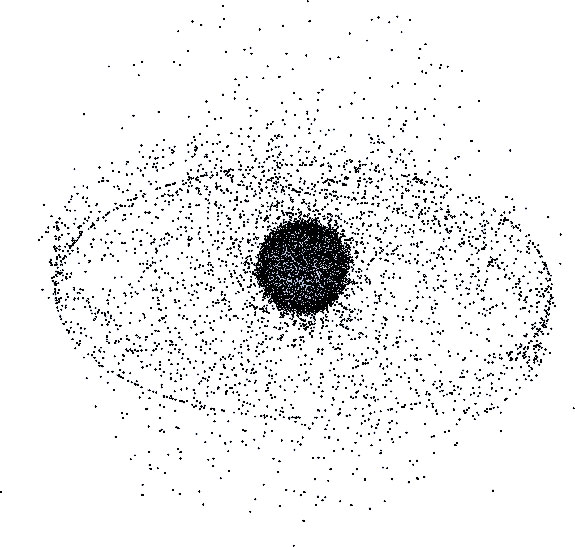One Tiny Piece of Space Debris Can Destroy a Satellite
Roughly 21,000 pieces of space junk orbit near the Earth

Space debris in Earth orbit as of July 2009. The dots are not to scale. Photo: NASA Orbital Debris Program Office
A plan by the Russian space agency to move the International Space Station out of the path of orbiting rubbish was put together and subsequently scrapped this week. The proposed maneuver was to make the orbiting station dodge some of the approximately 21,000 pieces of space debris whipping around the Earth at speeds up to “tens of thousands of kilometers per hour.” The orbital adjustment was scrapped when scientists re-calculated the threat to the ISS, finding it to be lower than they’d originally thought. But this current respite likely won’t last.
Stuart Clark writes in The Guardian:
Douglas Adams famously said “space is big”, which is true when you consider the whole universe. However, the space around Earth is not, and we are filling it more fully every day…
For years now, the ISS has been dodging collisions. Some of the latest manoeuvres took place in April 2011 and January 2012. What may not be so obvious is that many of its “near-misses” are due to fragments from a single event in 2009 that shocked the aerospace community.
On February 10, 2009, an inactive Russian satellite, Kosmos 2251, slammed into a communications satellite operated by the US company Iridium. That collision sent a massive cloud of debris into orbit around the Earth, with roughly 2,000 pieces being four inches across or larger. Though modest in size, even these small chunks of orbiting space junk can cause huge amounts of damage because they’re moving so quickly. And, says the Secure World Foundation, “uch of this debris will remain in orbit for decades or longer, posing a collision risk to other objects in Low Earth Orbit (LEO).”
Clark writes that humankind’s continued push into space could lead to something called Kessler syndrome. In 1978, he says, NASA’s Donald Kessler suggested that “as the number of satellites rose, so would the risk of accidental collisions. The resulting debris would take out further satellites, sparking a chain reaction that would swiftly encircle the planet with a vast cloud of debris. Orbits would then become unusable because anything placed up there would be sandblasted into smithereens, exacerbating the problem. Eventually our access to space would be lost.”
More from Smithsonian.com:
Navy Wants to Thwart Space Debris By Releasing More Space Debris
Space Garbage: The Dark Cloud Above
/https://tf-cmsv2-smithsonianmag-media.s3.amazonaws.com/accounts/headshot/smartnews-colin-schultz-240.jpg)
/https://tf-cmsv2-smithsonianmag-media.s3.amazonaws.com/accounts/headshot/smartnews-colin-schultz-240.jpg)